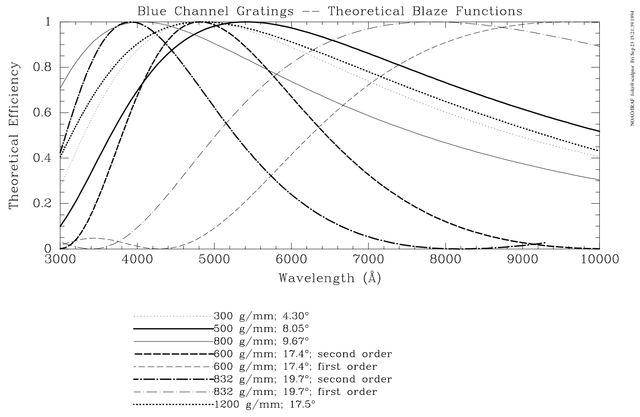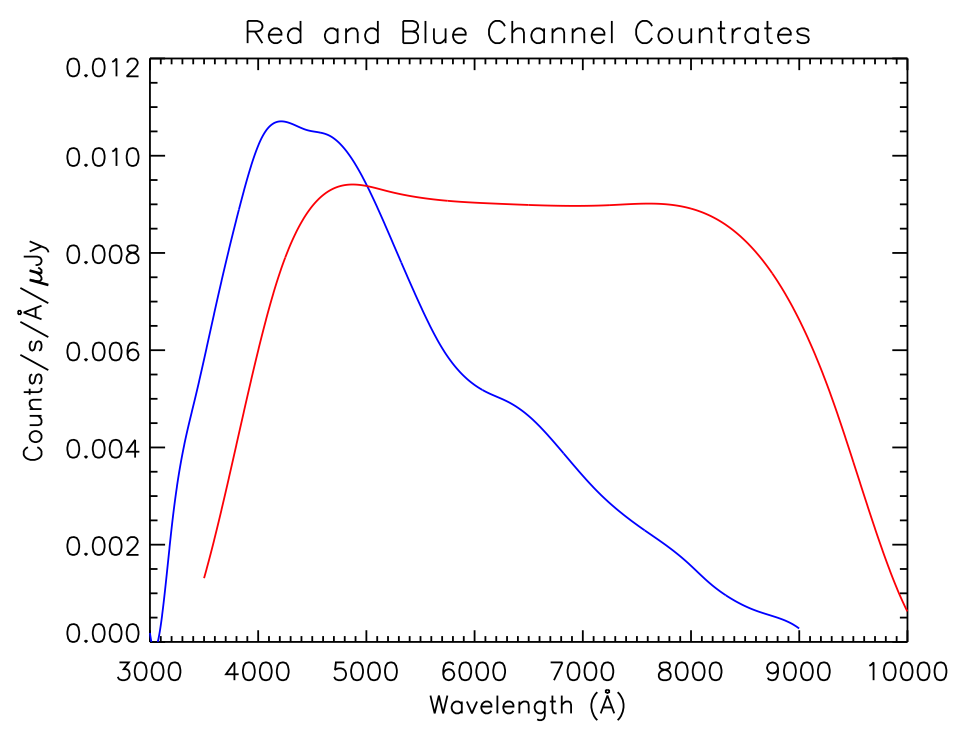Blue Channel Details
Information on the instrument rotator
| Grating (lines/mm) | Blaze (order/λ Å) | Blaze Angle(°) | Anamorphic Mag | R (@ Blaze, 1″ slit) | Resolution (Å) | Dispersion (Å/pix) | Coveragea (Å) |
| 300 | 1st/4800 | 4.30 | 0.96 | 740 | 6.47 | 1.96 | 5268b |
| 500 | 1st/5410 | 8.05 | 0.93 | 1430 | 3.79 | 1.19 | 3198 |
| 800 | 1st/4050 | 9.67 | 0.91 | 1730 | 2.34 | 0.75 | 2016 |
| 600 | 2nd/4800 | 17.4 | 0.85 | 3310 | 1.45 | 0.50 | 1344 |
| 1st/9630 | 17.4 | 0.85 | 3330 | 2.90 | 1.00 | 2688 | |
| 832 | 2nd/3900 | 19.7 | 0.83 | 3830 | 1.02 | 0.36 | 968 |
| 1st/7790 | 19.7 | 0.83 | 3830 | 2.04 | 0.72 | 1935 | |
| 1200 | 1st/4830 | 17.5 | 0.84 | 3340 | 1.45 | 0.50 | 1344 |
| Echellette | 12th/4480 | 42.0 | 0.61 | 11480 | 0.39 | 0.19 | 360c |
Theoretical Blaze Functions

Or view a pdf version of the theoretical blaze functions.
An illustration of the expected count rate (for a flat-spectrum (in F_nu) source of 1 micro-Jansky) per Angstrom is shown below.

The same data can be found in PDF form and in tabulated form (Blue Channel, Red Channel).
Cross Dispersed Echellette Mode
NOTE: If you are submitting a proposal to use this configuration, please specify very clearly that this is the case in order to alert the telescope schedulers.
The Blue Channel Echellette grating is a 6″ x 10″, custom-ruled, 240 g/mm grating which can be used in orders 8-17 simultaneously, giving coverage from 3100-7000 Å with a 10 arcsecond long slit. Cross dispersion is provided by a large quartz prism which is inserted into the beam between the grating and the camera.
In a perfect spectrograph, the spectral resolution of this configuration is about 10,000 with a 1 arcsec wide slit (i.e. 30 km/sec). In practice, the focus degrades at the ends of the orders. During initial tests, we picked a focus value that gave a decent compromise focus over much of the frame. The resulting resolution varied from about 30 to 60 km/sec.
Sample Images:
Several images which summarize the salient operating characteristics of this configuration are available as jpgs. Note that in these images, the 17th order is difficult to see or underexposed; while the order does not appear in these sample images, the data from the order is usable and calibratable. It is worth noting that the 8th order currently falls slightly off the detector near the atmospheric B-band. The percentage of the trace lost in this manner is small and will likely not strongly affect point source spectroscopy.
Throughput:
Throughput measurements are also not available for the cross-dispersed configuration. There is however historical evidence that on a photons/Å/second basis, this configuration is clearly not competitive with the other gratings — we estimate that it may be a factor of 2 or more slower when compared to the other gratings at their blazed wavelengths. Some of this is attributable to losses from the prism; the rest (and probably the lion’s share) is due to the grating. However, some of this factor is compensated for by the fact that one is atop the blaze in each of the echellette’s orders as opposed to the normal gratings where the blaze can often compromise performance. This grating could be very useful for projects requiring moderately-high resolution over a wide wavelength range. The data are relatively easy to reduce (up to the point where adjacent orders are combined) using the “echelle” package in IRAF.
Scheduling Constraints:
Configuration of the spectrograph for cross-dispersed work requires that the spectrograph be taken off the telescope. In practice, this means that the spectrograph is scheduled for cross-dispersed “runs”. It is possible to leave the prism in and use other gratings, but there is significant throughput loss and the spectra are quite curved. It is also possible to mount the Red Channel on the Blue Channel and use it for backup programs in case of inclement conditions. Prospective users of the Echellette should contact a staff scientist.
